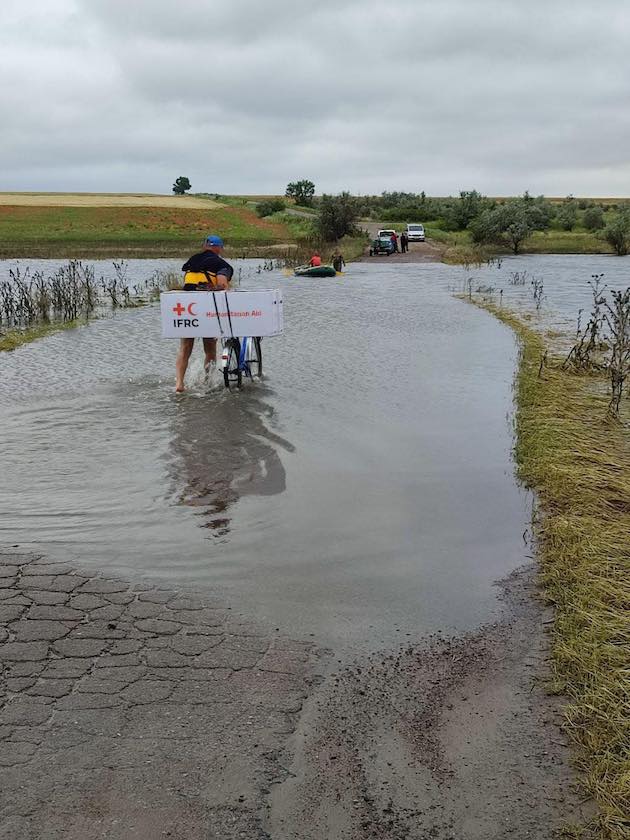Environmental Crisis Compounds Humanitarian Disaster Following Dam Destruction — Global Issues
BRATISLAVA, Jun 23 (IPS) – As well as creating a humanitarian crisis, the destruction of the Nova Kakhovka dam in Ukraine has wrought enormous environmental damage which may never be undone, ecologists have said.
The collapse of the dam in the Kherson region on June 6 put more than 40,000 people in immediate danger from flooding and left hundreds of thousands without access to drinking water, according to Ukrainian officials.
The reservoir at the dam, which continued to drain days after the dam’s destruction, held 18 cubic kilometres (4.3 cubic miles) of water – a volume roughly equal to the Great Salt Lake in Utah – and was the source of fresh water for large parts of the south of the country.
The disaster – which Kyiv says was the result of Russian sabotage – flooded scores of villages, towns and cities along the Dnieper River. Entire settlements were destroyed, with houses washed away or almost completely submerged by the floodwaters.
Although those waters have begun to recede in many places now, and the immediate risk from drowning has largely abated, other grave dangers remain, with Ukraine’s health ministry warning of the threat of water and food-borne diseases as dead bodies, chemicals, landfills, and waste from toilets could contaminate floodwaters and wells.
President Volodymyr Zelensky also highlighted a potential danger from anthrax as floodwaters may have disturbed animal burial sites, and Health Ministry officials told IPS that they were especially concerned about the risk of cholera in the weeks to come.
The death toll was at least 52, with Russia giving 35 in its territory and Ukraine saying 17.
And those who have been evacuated are unlikely to be able to return to their homes for some time, if at all, adding tens of thousands of already vulnerable people to the country’s ongoing crisis of internal displacement.
“There are already 5 million people internally displaced in Ukraine. This will put more strain on already stretched services,” Olivia Headon, spokesperson for the International Organisation for Migration, which is helping with rescue efforts in affected areas, told IPS.
But while the human toll of the disaster is becoming increasingly apparent, so too is its massive environmental impact.
Ukrainian Deputy Foreign Minister Andrij Melnyk has called the destruction of the dam “the worst environmental catastrophe in Europe since the Chernobyl disaster”, and many local experts believe the ecological effects will be felt for decades to come.
“Some ecosystems could recover within a dozen years from the flooding itself the drop in groundwater level upstream of the dam is permanent – unless the dam is rebuilt – so ecosystems will never recover,” Natalia Gozak, Wildlife Rescue Field Officer in Ukraine for the International Fund for Animal Welfare (IFAW), told IPS.
The area downstream from the dam – which includes three national parks – is rich in wildlife, some of it very rare.
Local environmental groups estimate that hundreds of thousands of animals have been affected by the dam’s destruction and that tens of thousands have been killed.
They fear a loss of endemic endangered species – areas home to nearly all known locations of the rare ant species Liometopum microcephalum, as well as 70% of the world population of Nordmann’s birch mouse (Sicista loriger), have been flooded.
Meanwhile, ecosystems which were already endangered are now having to deal with either too much or too little water and could disappear.
Ecologists are also worried about a massive loss of bird life while the draining of the reservoir at the dam will also result in major freshwater fish stocks in Ukraine being lost.
The loss of water from the dam reservoir and the major canals it served also spells an end to water supplies for land used to grow crops and other produce which feeds not only Ukrainians but many millions in developing countries too. Forty percent of the World Food Programme’s wheat supplies come from Ukraine.
“In future years, the greatest impact will be seen in southern agricultural areas, which are now left without water supplies. These areas will already have changed next summer depending on what adaptation measures are possible and what action is taken,” said Gozak.
She added that in areas where irrigation channels are no longer being filled from the reservoir, agriculture will stop. “It is possible there will be desertification ,” she said.
The IFAW says this drying of land will subsequently affect local microclimates and cause temperature shifts, while wind erosion will blow sand and soil all over neighbouring areas, impacting both people and nature.
Meanwhile, there are other long-term environmental threats.
Pollution is one as floodwaters have washed an estimated 150 tons of machine oil has been washed as far down as the Black Sea, according to Ukrainian officials. Huge oil slicks have also been seen on the waters in Kherson city’s port and industrial facilities.
And there have been warnings that parts of the river and surrounding lands may now be full of mines.
Some areas of Ukraine have been heavily mined since the start of Russia’s full-scale invasion last year, and it is believed the floodwaters dislodged many of them.
While there have been reports of some exploding as they hit debris on their way downstream, many are likely to have remained unexploded and covered in silt and mud or buried under other debris.
International rescue groups say that finding where they are and then demining them would be a very slow process, even without the ongoing war.
“We’re mapping the likelihood of where the mines were and where they might end up. The area around the dam was heavily mined to stop an amphibious assault, and we don’t know precisely how many mines there are. There could be thousands of mines involved, but we hope not tens of thousands,” Andrew Duncan, a weapon contamination coordinator for the International Committee of the Red Cross (ICRC), told IPS.
“If the fighting stopped and we were able to get into the area, it would be a case of all reasonable effort being made to locate the mines. But this is a very slow process. Any affected land will be out of commission for years,” he added.
But that is not all.
About 150 kilometres upstream from Nova Kakhovka is the Zaporizhzhia Nuclear Power Plant which draws its cooling water from the dam’s reservoir. The reactors at the plant, which had been under the control of Russian forces since early on in the war, had been shut down prior to the disaster, but they still needed water to cool them and prevent a nuclear catastrophe.
While officials at the International Atomic Energy Agency (IAEA) have said that alternative sources, including a large pond next to the plant, can provide cooling water for a number of months, the disaster has highlighted the potential for an even greater catastrophe at the site, others say.
Ukrainian nuclear scientist Mariana Budjeryn, Senior Research Associate at the Project on Managing the Atom, Harvard Kennedy School, told international media: “If the Russians would do this with Kakhovka, there’s no guarantee they won’t blow up the reactor units at the Zaporizhzhia plant that are also reportedly mined – three of the six. It wouldn’t cause a Chernobyl, but massive disruption, local contamination and long-term damage to Ukraine.”
Regardless of what may or may not come to pass at the nuclear plant, the effects of the dam’s destruction will be felt by both people and nature for a long time to come.
Olena Kozachenko (NOT REAL NAME), an office worker from the Korabel district in the Kherson region, told IPS: “We’re all going to have to live with the dangers, such as dislodged mines, for a long time after the flooding.”
Gozak added: “The human toll of the disaster is probably greater than the environmental toll it will take years and years for ecosystems and habitats to get back to how they were if it can happen at all.”
IPS UN Bureau Report
Follow @IPSNewsUNBureau
Follow IPS News UN Bureau on Instagram
© Inter Press Service (2023) — All Rights ReservedOriginal source: Inter Press Service
Check out our Latest News and Follow us at Facebook
Original Source







